Masters of Public Health Report: Disease Risks at Commonwealth Games
VerifiedAdded on 2020/03/23
|35
|7116
|107
Report
AI Summary
This report, prepared for a Master of Public Health program, assesses the potential risks of communicable diseases at the 2018 Commonwealth Games held in Gold Coast, Australia. It begins with a background on the games, emphasizing their global significance and the influx of participants from various countries. The report identifies several communicable diseases of concern, including influenza, measles, meningitis, pertussis, gastro infections, malaria, dengue, and Zika virus, considering their prevalence in participating nations. It explores the underlying causes of disease prevalence, such as socio-economic conditions, environmental factors, and climatic variations. The report hypothesizes the potential for disease importation and local transmission, analyzing temporal trends from 2012-2016 to provide insights for the Australian health system. The objectives are to identify diseases with high transmission risks and to summarize disease trends in participating countries. The methodology involves a meta-analysis of existing literature, incorporating quantitative results to provide more precise outcomes. The report highlights the importance of preventive measures and control strategies to mitigate health risks during the games.
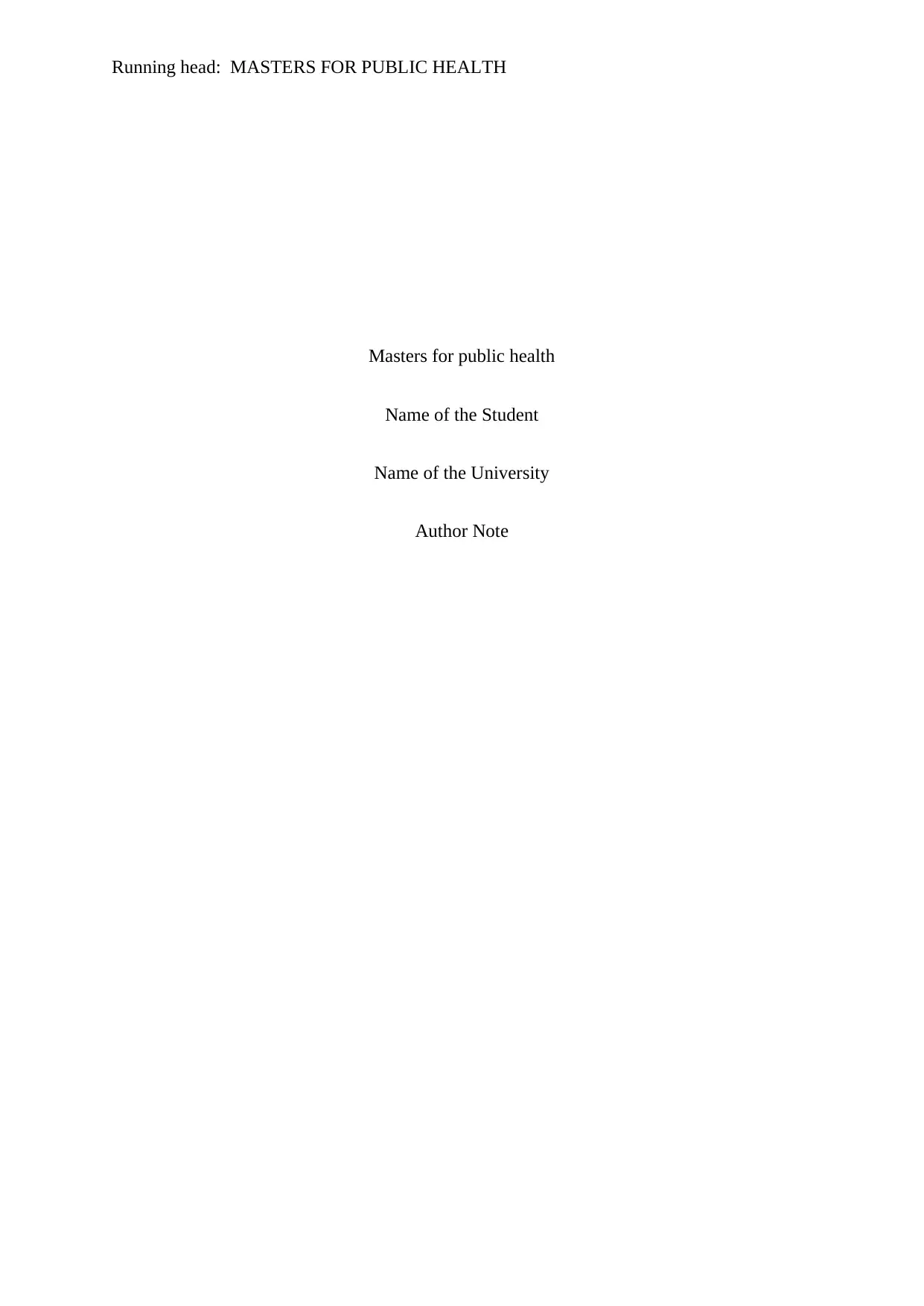
Running head: MASTERS FOR PUBLIC HEALTH
Masters for public health
Name of the Student
Name of the University
Author Note
Masters for public health
Name of the Student
Name of the University
Author Note
Paraphrase This Document
Need a fresh take? Get an instant paraphrase of this document with our AI Paraphraser
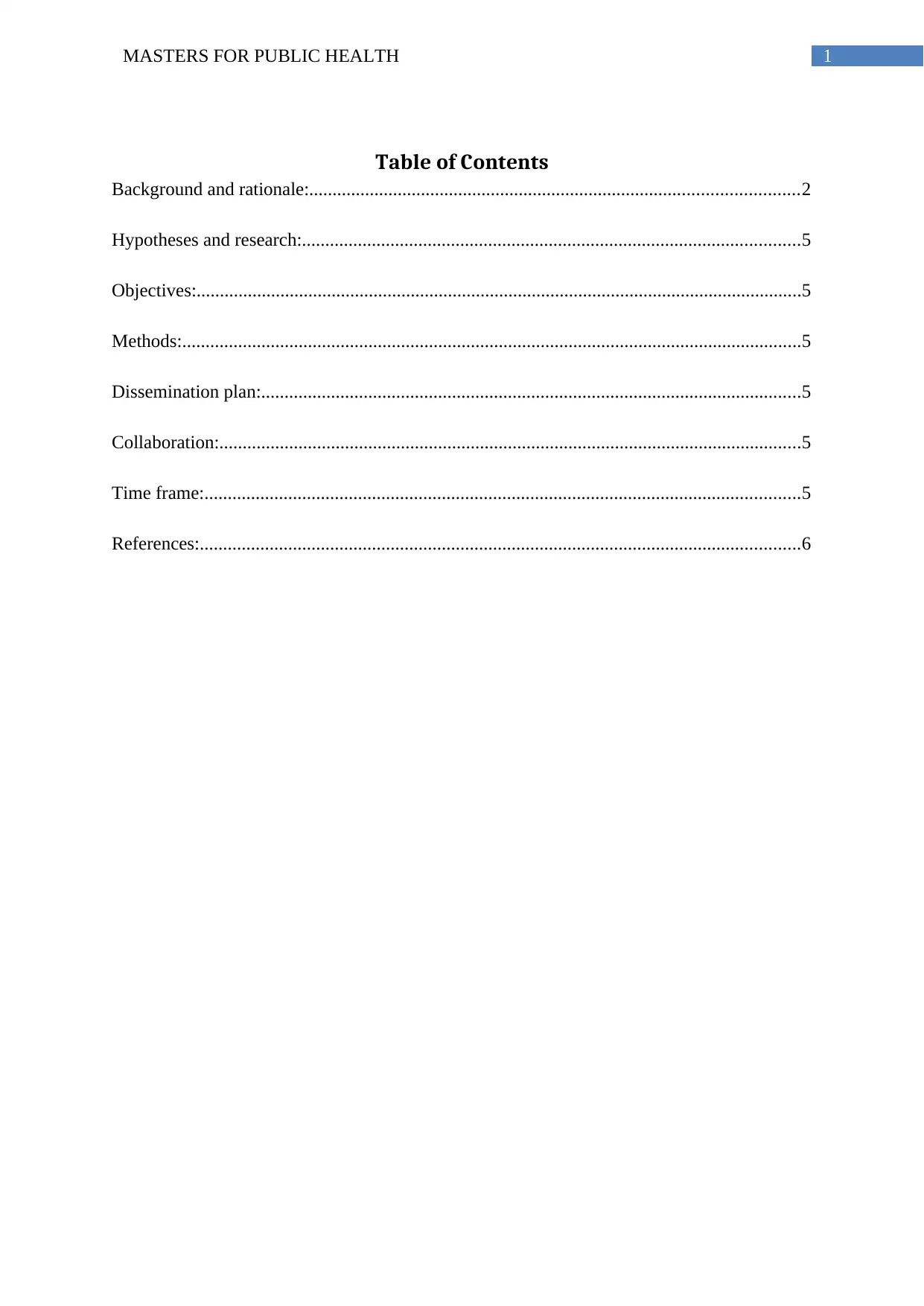
1MASTERS FOR PUBLIC HEALTH
Table of Contents
Background and rationale:.........................................................................................................2
Hypotheses and research:...........................................................................................................5
Objectives:..................................................................................................................................5
Methods:.....................................................................................................................................5
Dissemination plan:....................................................................................................................5
Collaboration:.............................................................................................................................5
Time frame:................................................................................................................................5
References:.................................................................................................................................6
Table of Contents
Background and rationale:.........................................................................................................2
Hypotheses and research:...........................................................................................................5
Objectives:..................................................................................................................................5
Methods:.....................................................................................................................................5
Dissemination plan:....................................................................................................................5
Collaboration:.............................................................................................................................5
Time frame:................................................................................................................................5
References:.................................................................................................................................6
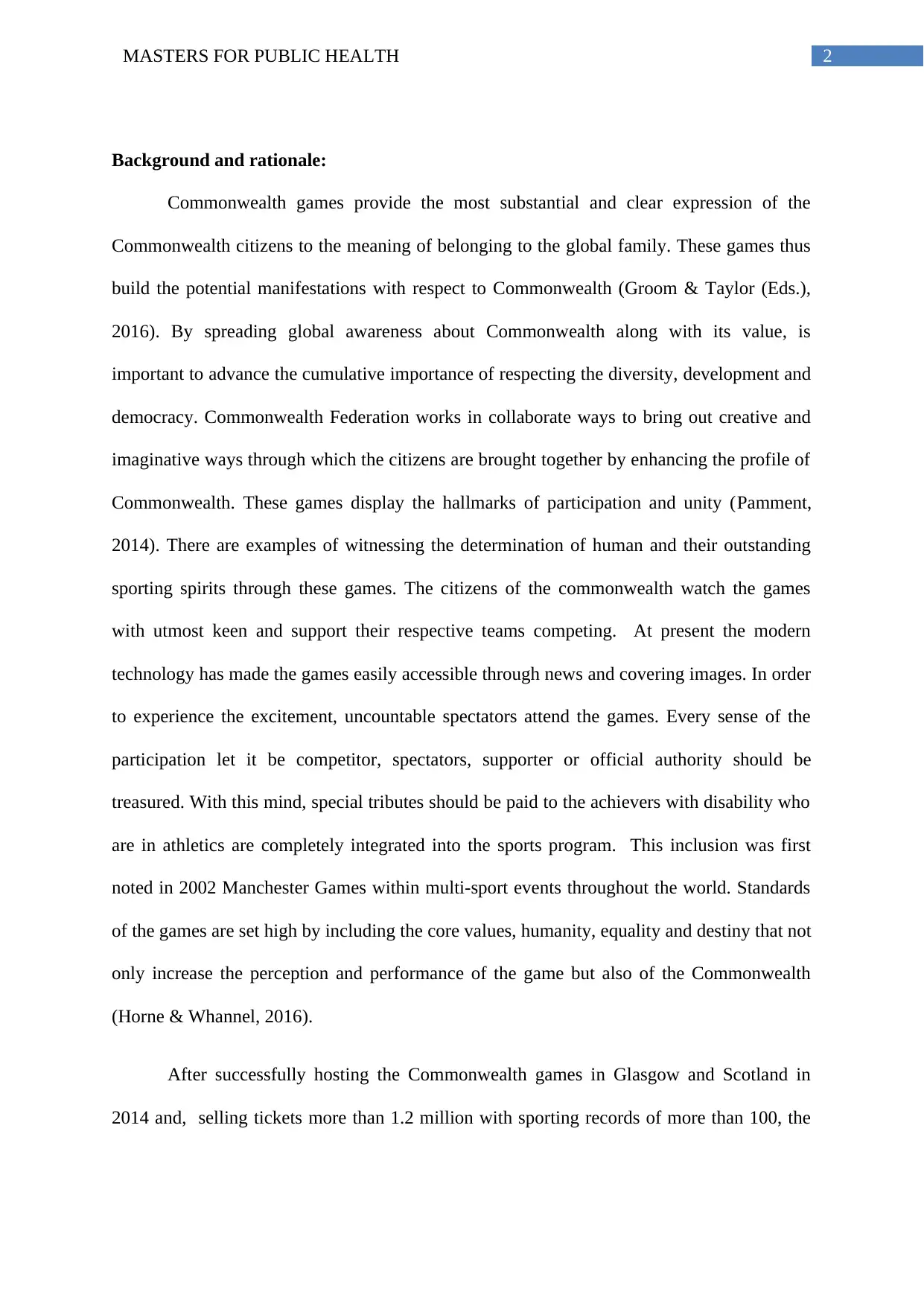
2MASTERS FOR PUBLIC HEALTH
Background and rationale:
Commonwealth games provide the most substantial and clear expression of the
Commonwealth citizens to the meaning of belonging to the global family. These games thus
build the potential manifestations with respect to Commonwealth (Groom & Taylor (Eds.),
2016). By spreading global awareness about Commonwealth along with its value, is
important to advance the cumulative importance of respecting the diversity, development and
democracy. Commonwealth Federation works in collaborate ways to bring out creative and
imaginative ways through which the citizens are brought together by enhancing the profile of
Commonwealth. These games display the hallmarks of participation and unity (Pamment,
2014). There are examples of witnessing the determination of human and their outstanding
sporting spirits through these games. The citizens of the commonwealth watch the games
with utmost keen and support their respective teams competing. At present the modern
technology has made the games easily accessible through news and covering images. In order
to experience the excitement, uncountable spectators attend the games. Every sense of the
participation let it be competitor, spectators, supporter or official authority should be
treasured. With this mind, special tributes should be paid to the achievers with disability who
are in athletics are completely integrated into the sports program. This inclusion was first
noted in 2002 Manchester Games within multi-sport events throughout the world. Standards
of the games are set high by including the core values, humanity, equality and destiny that not
only increase the perception and performance of the game but also of the Commonwealth
(Horne & Whannel, 2016).
After successfully hosting the Commonwealth games in Glasgow and Scotland in
2014 and, selling tickets more than 1.2 million with sporting records of more than 100, the
Background and rationale:
Commonwealth games provide the most substantial and clear expression of the
Commonwealth citizens to the meaning of belonging to the global family. These games thus
build the potential manifestations with respect to Commonwealth (Groom & Taylor (Eds.),
2016). By spreading global awareness about Commonwealth along with its value, is
important to advance the cumulative importance of respecting the diversity, development and
democracy. Commonwealth Federation works in collaborate ways to bring out creative and
imaginative ways through which the citizens are brought together by enhancing the profile of
Commonwealth. These games display the hallmarks of participation and unity (Pamment,
2014). There are examples of witnessing the determination of human and their outstanding
sporting spirits through these games. The citizens of the commonwealth watch the games
with utmost keen and support their respective teams competing. At present the modern
technology has made the games easily accessible through news and covering images. In order
to experience the excitement, uncountable spectators attend the games. Every sense of the
participation let it be competitor, spectators, supporter or official authority should be
treasured. With this mind, special tributes should be paid to the achievers with disability who
are in athletics are completely integrated into the sports program. This inclusion was first
noted in 2002 Manchester Games within multi-sport events throughout the world. Standards
of the games are set high by including the core values, humanity, equality and destiny that not
only increase the perception and performance of the game but also of the Commonwealth
(Horne & Whannel, 2016).
After successfully hosting the Commonwealth games in Glasgow and Scotland in
2014 and, selling tickets more than 1.2 million with sporting records of more than 100, the
⊘ This is a preview!⊘
Do you want full access?
Subscribe today to unlock all pages.

Trusted by 1+ million students worldwide
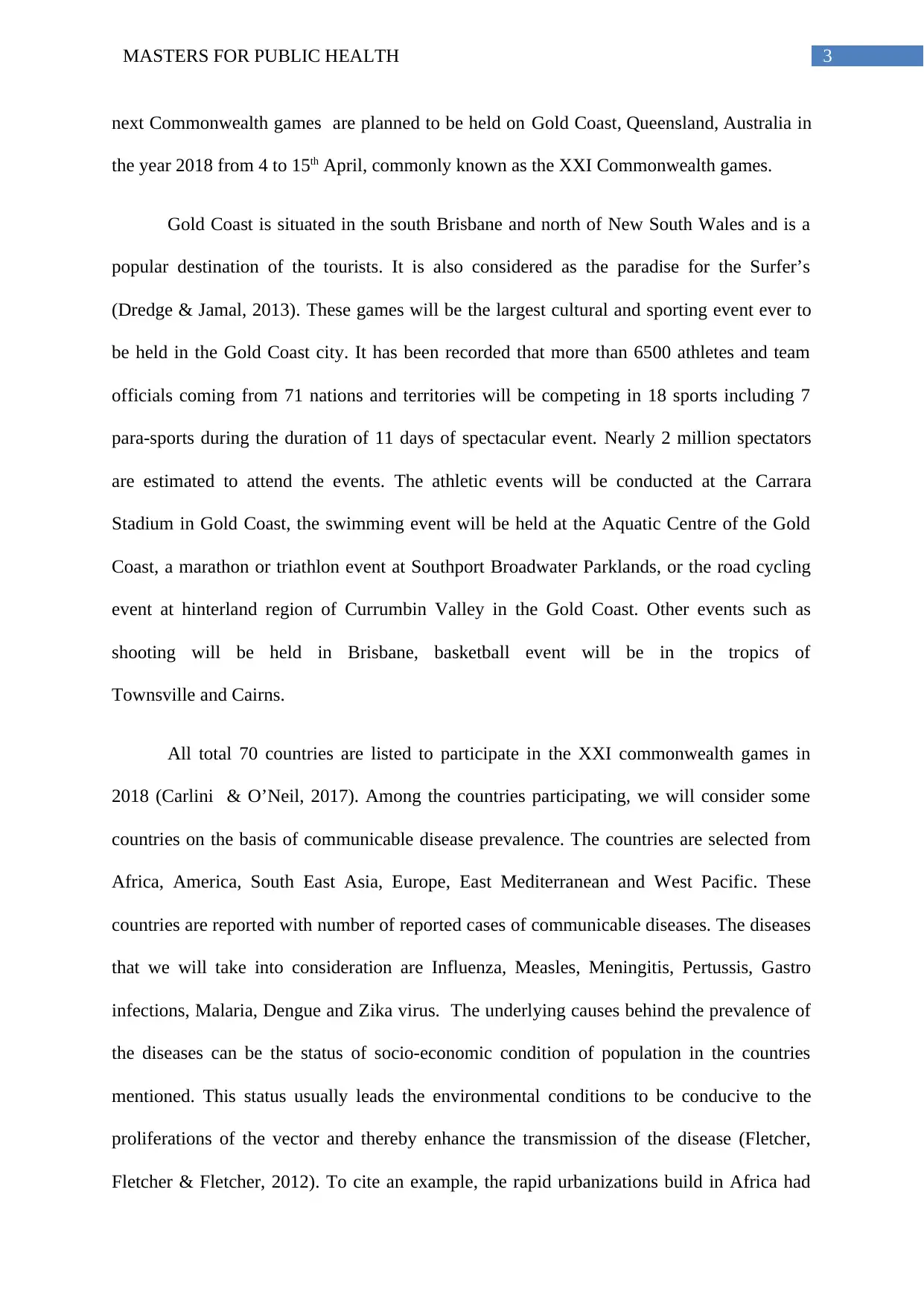
3MASTERS FOR PUBLIC HEALTH
next Commonwealth games are planned to be held on Gold Coast, Queensland, Australia in
the year 2018 from 4 to 15th April, commonly known as the XXI Commonwealth games.
Gold Coast is situated in the south Brisbane and north of New South Wales and is a
popular destination of the tourists. It is also considered as the paradise for the Surfer’s
(Dredge & Jamal, 2013). These games will be the largest cultural and sporting event ever to
be held in the Gold Coast city. It has been recorded that more than 6500 athletes and team
officials coming from 71 nations and territories will be competing in 18 sports including 7
para-sports during the duration of 11 days of spectacular event. Nearly 2 million spectators
are estimated to attend the events. The athletic events will be conducted at the Carrara
Stadium in Gold Coast, the swimming event will be held at the Aquatic Centre of the Gold
Coast, a marathon or triathlon event at Southport Broadwater Parklands, or the road cycling
event at hinterland region of Currumbin Valley in the Gold Coast. Other events such as
shooting will be held in Brisbane, basketball event will be in the tropics of
Townsville and Cairns.
All total 70 countries are listed to participate in the XXI commonwealth games in
2018 (Carlini & O’Neil, 2017). Among the countries participating, we will consider some
countries on the basis of communicable disease prevalence. The countries are selected from
Africa, America, South East Asia, Europe, East Mediterranean and West Pacific. These
countries are reported with number of reported cases of communicable diseases. The diseases
that we will take into consideration are Influenza, Measles, Meningitis, Pertussis, Gastro
infections, Malaria, Dengue and Zika virus. The underlying causes behind the prevalence of
the diseases can be the status of socio-economic condition of population in the countries
mentioned. This status usually leads the environmental conditions to be conducive to the
proliferations of the vector and thereby enhance the transmission of the disease (Fletcher,
Fletcher & Fletcher, 2012). To cite an example, the rapid urbanizations build in Africa had
next Commonwealth games are planned to be held on Gold Coast, Queensland, Australia in
the year 2018 from 4 to 15th April, commonly known as the XXI Commonwealth games.
Gold Coast is situated in the south Brisbane and north of New South Wales and is a
popular destination of the tourists. It is also considered as the paradise for the Surfer’s
(Dredge & Jamal, 2013). These games will be the largest cultural and sporting event ever to
be held in the Gold Coast city. It has been recorded that more than 6500 athletes and team
officials coming from 71 nations and territories will be competing in 18 sports including 7
para-sports during the duration of 11 days of spectacular event. Nearly 2 million spectators
are estimated to attend the events. The athletic events will be conducted at the Carrara
Stadium in Gold Coast, the swimming event will be held at the Aquatic Centre of the Gold
Coast, a marathon or triathlon event at Southport Broadwater Parklands, or the road cycling
event at hinterland region of Currumbin Valley in the Gold Coast. Other events such as
shooting will be held in Brisbane, basketball event will be in the tropics of
Townsville and Cairns.
All total 70 countries are listed to participate in the XXI commonwealth games in
2018 (Carlini & O’Neil, 2017). Among the countries participating, we will consider some
countries on the basis of communicable disease prevalence. The countries are selected from
Africa, America, South East Asia, Europe, East Mediterranean and West Pacific. These
countries are reported with number of reported cases of communicable diseases. The diseases
that we will take into consideration are Influenza, Measles, Meningitis, Pertussis, Gastro
infections, Malaria, Dengue and Zika virus. The underlying causes behind the prevalence of
the diseases can be the status of socio-economic condition of population in the countries
mentioned. This status usually leads the environmental conditions to be conducive to the
proliferations of the vector and thereby enhance the transmission of the disease (Fletcher,
Fletcher & Fletcher, 2012). To cite an example, the rapid urbanizations build in Africa had
Paraphrase This Document
Need a fresh take? Get an instant paraphrase of this document with our AI Paraphraser
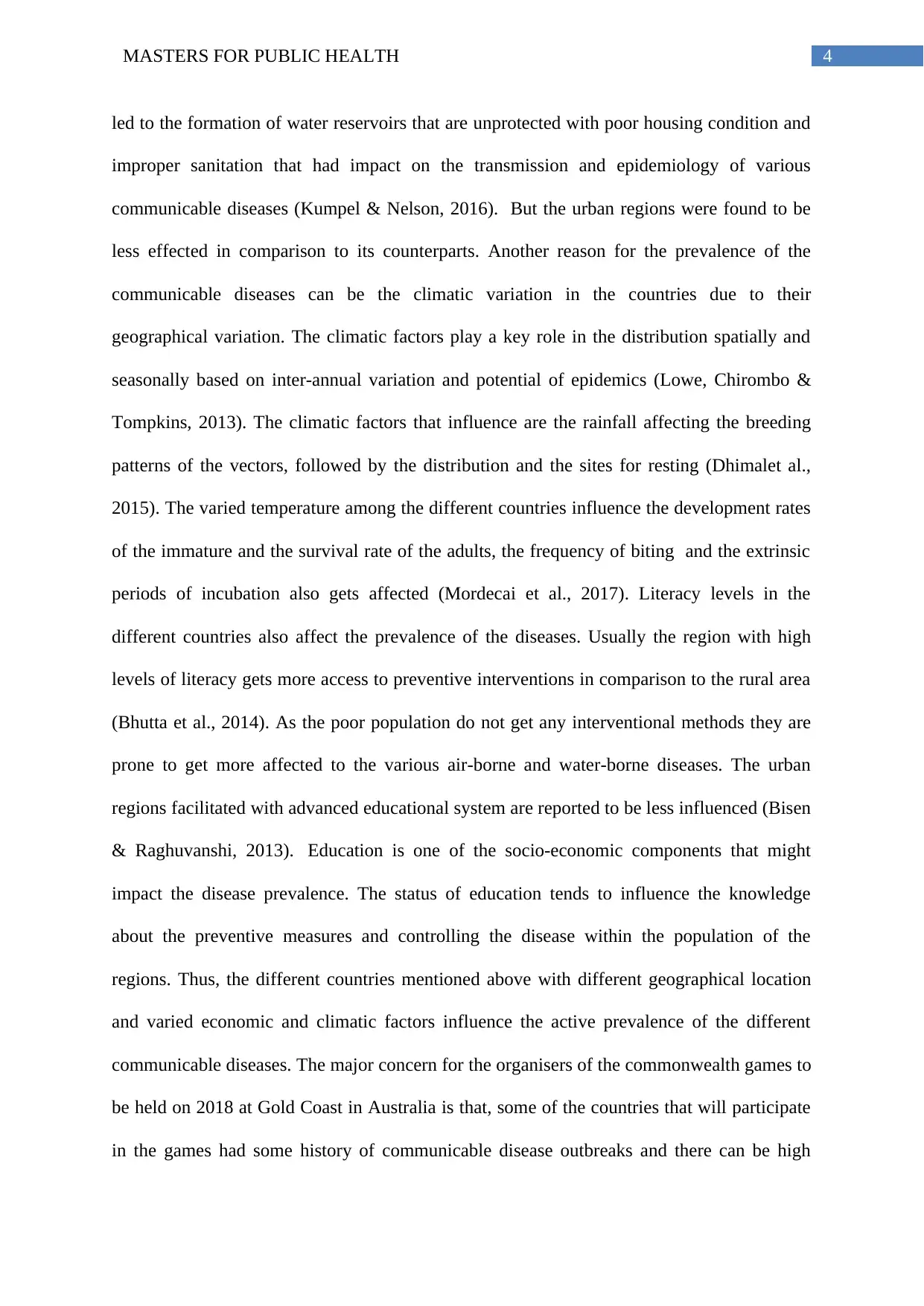
4MASTERS FOR PUBLIC HEALTH
led to the formation of water reservoirs that are unprotected with poor housing condition and
improper sanitation that had impact on the transmission and epidemiology of various
communicable diseases (Kumpel & Nelson, 2016). But the urban regions were found to be
less effected in comparison to its counterparts. Another reason for the prevalence of the
communicable diseases can be the climatic variation in the countries due to their
geographical variation. The climatic factors play a key role in the distribution spatially and
seasonally based on inter-annual variation and potential of epidemics (Lowe, Chirombo &
Tompkins, 2013). The climatic factors that influence are the rainfall affecting the breeding
patterns of the vectors, followed by the distribution and the sites for resting (Dhimalet al.,
2015). The varied temperature among the different countries influence the development rates
of the immature and the survival rate of the adults, the frequency of biting and the extrinsic
periods of incubation also gets affected (Mordecai et al., 2017). Literacy levels in the
different countries also affect the prevalence of the diseases. Usually the region with high
levels of literacy gets more access to preventive interventions in comparison to the rural area
(Bhutta et al., 2014). As the poor population do not get any interventional methods they are
prone to get more affected to the various air-borne and water-borne diseases. The urban
regions facilitated with advanced educational system are reported to be less influenced (Bisen
& Raghuvanshi, 2013). Education is one of the socio-economic components that might
impact the disease prevalence. The status of education tends to influence the knowledge
about the preventive measures and controlling the disease within the population of the
regions. Thus, the different countries mentioned above with different geographical location
and varied economic and climatic factors influence the active prevalence of the different
communicable diseases. The major concern for the organisers of the commonwealth games to
be held on 2018 at Gold Coast in Australia is that, some of the countries that will participate
in the games had some history of communicable disease outbreaks and there can be high
led to the formation of water reservoirs that are unprotected with poor housing condition and
improper sanitation that had impact on the transmission and epidemiology of various
communicable diseases (Kumpel & Nelson, 2016). But the urban regions were found to be
less effected in comparison to its counterparts. Another reason for the prevalence of the
communicable diseases can be the climatic variation in the countries due to their
geographical variation. The climatic factors play a key role in the distribution spatially and
seasonally based on inter-annual variation and potential of epidemics (Lowe, Chirombo &
Tompkins, 2013). The climatic factors that influence are the rainfall affecting the breeding
patterns of the vectors, followed by the distribution and the sites for resting (Dhimalet al.,
2015). The varied temperature among the different countries influence the development rates
of the immature and the survival rate of the adults, the frequency of biting and the extrinsic
periods of incubation also gets affected (Mordecai et al., 2017). Literacy levels in the
different countries also affect the prevalence of the diseases. Usually the region with high
levels of literacy gets more access to preventive interventions in comparison to the rural area
(Bhutta et al., 2014). As the poor population do not get any interventional methods they are
prone to get more affected to the various air-borne and water-borne diseases. The urban
regions facilitated with advanced educational system are reported to be less influenced (Bisen
& Raghuvanshi, 2013). Education is one of the socio-economic components that might
impact the disease prevalence. The status of education tends to influence the knowledge
about the preventive measures and controlling the disease within the population of the
regions. Thus, the different countries mentioned above with different geographical location
and varied economic and climatic factors influence the active prevalence of the different
communicable diseases. The major concern for the organisers of the commonwealth games to
be held on 2018 at Gold Coast in Australia is that, some of the countries that will participate
in the games had some history of communicable disease outbreaks and there can be high
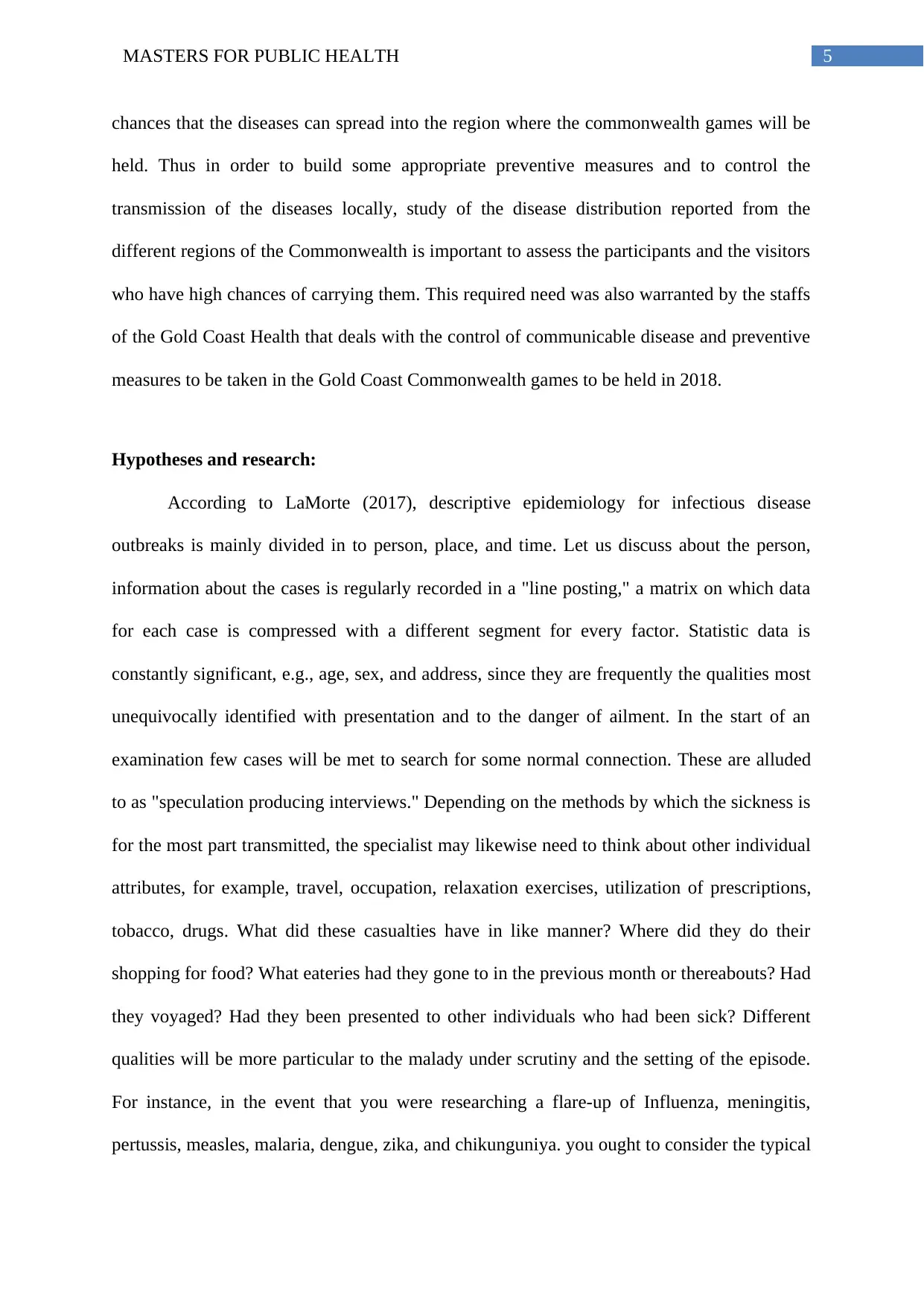
5MASTERS FOR PUBLIC HEALTH
chances that the diseases can spread into the region where the commonwealth games will be
held. Thus in order to build some appropriate preventive measures and to control the
transmission of the diseases locally, study of the disease distribution reported from the
different regions of the Commonwealth is important to assess the participants and the visitors
who have high chances of carrying them. This required need was also warranted by the staffs
of the Gold Coast Health that deals with the control of communicable disease and preventive
measures to be taken in the Gold Coast Commonwealth games to be held in 2018.
Hypotheses and research:
According to LaMorte (2017), descriptive epidemiology for infectious disease
outbreaks is mainly divided in to person, place, and time. Let us discuss about the person,
information about the cases is regularly recorded in a "line posting," a matrix on which data
for each case is compressed with a different segment for every factor. Statistic data is
constantly significant, e.g., age, sex, and address, since they are frequently the qualities most
unequivocally identified with presentation and to the danger of ailment. In the start of an
examination few cases will be met to search for some normal connection. These are alluded
to as "speculation producing interviews." Depending on the methods by which the sickness is
for the most part transmitted, the specialist may likewise need to think about other individual
attributes, for example, travel, occupation, relaxation exercises, utilization of prescriptions,
tobacco, drugs. What did these casualties have in like manner? Where did they do their
shopping for food? What eateries had they gone to in the previous month or thereabouts? Had
they voyaged? Had they been presented to other individuals who had been sick? Different
qualities will be more particular to the malady under scrutiny and the setting of the episode.
For instance, in the event that you were researching a flare-up of Influenza, meningitis,
pertussis, measles, malaria, dengue, zika, and chikunguniya. you ought to consider the typical
chances that the diseases can spread into the region where the commonwealth games will be
held. Thus in order to build some appropriate preventive measures and to control the
transmission of the diseases locally, study of the disease distribution reported from the
different regions of the Commonwealth is important to assess the participants and the visitors
who have high chances of carrying them. This required need was also warranted by the staffs
of the Gold Coast Health that deals with the control of communicable disease and preventive
measures to be taken in the Gold Coast Commonwealth games to be held in 2018.
Hypotheses and research:
According to LaMorte (2017), descriptive epidemiology for infectious disease
outbreaks is mainly divided in to person, place, and time. Let us discuss about the person,
information about the cases is regularly recorded in a "line posting," a matrix on which data
for each case is compressed with a different segment for every factor. Statistic data is
constantly significant, e.g., age, sex, and address, since they are frequently the qualities most
unequivocally identified with presentation and to the danger of ailment. In the start of an
examination few cases will be met to search for some normal connection. These are alluded
to as "speculation producing interviews." Depending on the methods by which the sickness is
for the most part transmitted, the specialist may likewise need to think about other individual
attributes, for example, travel, occupation, relaxation exercises, utilization of prescriptions,
tobacco, drugs. What did these casualties have in like manner? Where did they do their
shopping for food? What eateries had they gone to in the previous month or thereabouts? Had
they voyaged? Had they been presented to other individuals who had been sick? Different
qualities will be more particular to the malady under scrutiny and the setting of the episode.
For instance, in the event that you were researching a flare-up of Influenza, meningitis,
pertussis, measles, malaria, dengue, zika, and chikunguniya. you ought to consider the typical
⊘ This is a preview!⊘
Do you want full access?
Subscribe today to unlock all pages.

Trusted by 1+ million students worldwide
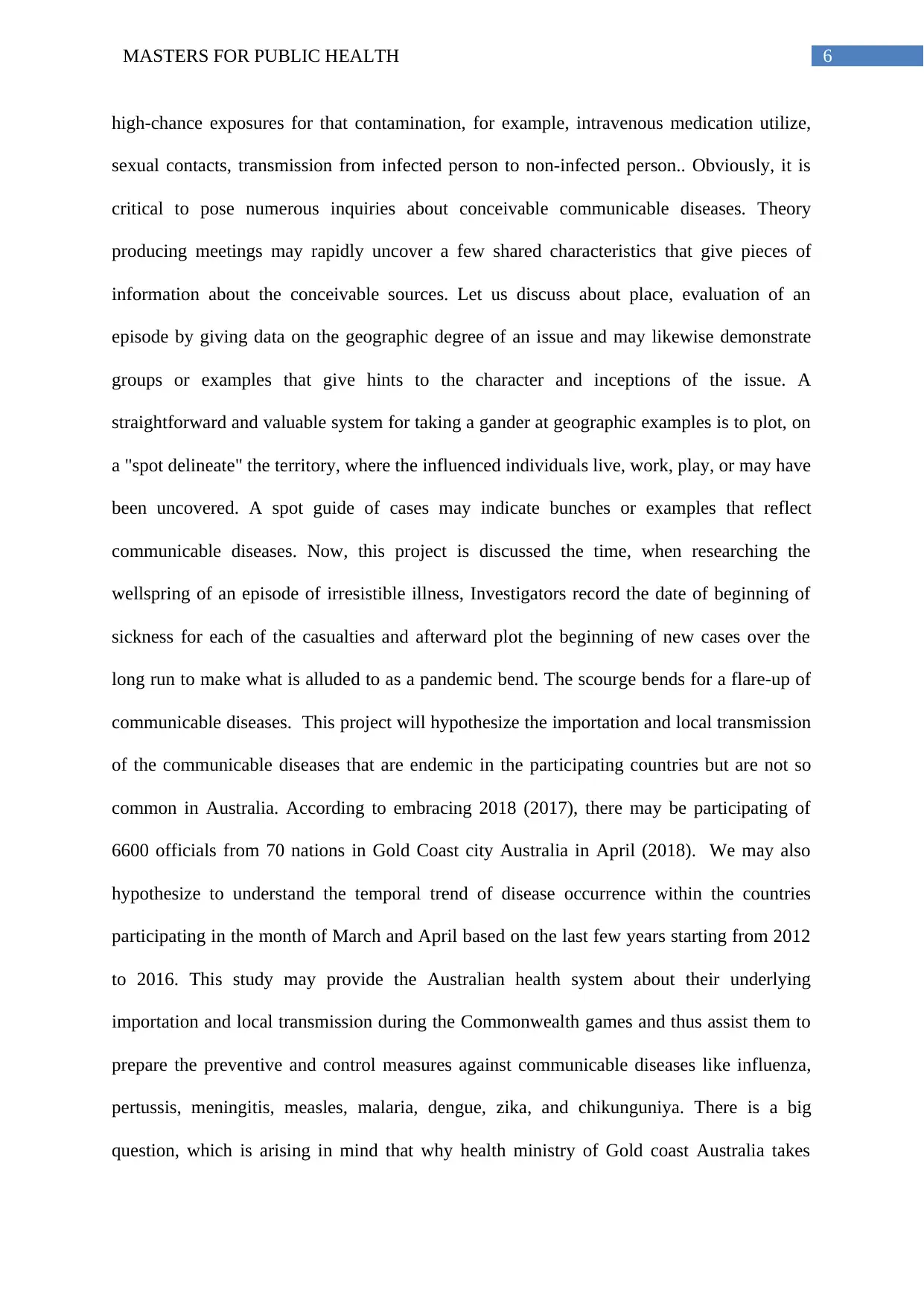
6MASTERS FOR PUBLIC HEALTH
high-chance exposures for that contamination, for example, intravenous medication utilize,
sexual contacts, transmission from infected person to non-infected person.. Obviously, it is
critical to pose numerous inquiries about conceivable communicable diseases. Theory
producing meetings may rapidly uncover a few shared characteristics that give pieces of
information about the conceivable sources. Let us discuss about place, evaluation of an
episode by giving data on the geographic degree of an issue and may likewise demonstrate
groups or examples that give hints to the character and inceptions of the issue. A
straightforward and valuable system for taking a gander at geographic examples is to plot, on
a "spot delineate" the territory, where the influenced individuals live, work, play, or may have
been uncovered. A spot guide of cases may indicate bunches or examples that reflect
communicable diseases. Now, this project is discussed the time, when researching the
wellspring of an episode of irresistible illness, Investigators record the date of beginning of
sickness for each of the casualties and afterward plot the beginning of new cases over the
long run to make what is alluded to as a pandemic bend. The scourge bends for a flare-up of
communicable diseases. This project will hypothesize the importation and local transmission
of the communicable diseases that are endemic in the participating countries but are not so
common in Australia. According to embracing 2018 (2017), there may be participating of
6600 officials from 70 nations in Gold Coast city Australia in April (2018). We may also
hypothesize to understand the temporal trend of disease occurrence within the countries
participating in the month of March and April based on the last few years starting from 2012
to 2016. This study may provide the Australian health system about their underlying
importation and local transmission during the Commonwealth games and thus assist them to
prepare the preventive and control measures against communicable diseases like influenza,
pertussis, meningitis, measles, malaria, dengue, zika, and chikunguniya. There is a big
question, which is arising in mind that why health ministry of Gold coast Australia takes
high-chance exposures for that contamination, for example, intravenous medication utilize,
sexual contacts, transmission from infected person to non-infected person.. Obviously, it is
critical to pose numerous inquiries about conceivable communicable diseases. Theory
producing meetings may rapidly uncover a few shared characteristics that give pieces of
information about the conceivable sources. Let us discuss about place, evaluation of an
episode by giving data on the geographic degree of an issue and may likewise demonstrate
groups or examples that give hints to the character and inceptions of the issue. A
straightforward and valuable system for taking a gander at geographic examples is to plot, on
a "spot delineate" the territory, where the influenced individuals live, work, play, or may have
been uncovered. A spot guide of cases may indicate bunches or examples that reflect
communicable diseases. Now, this project is discussed the time, when researching the
wellspring of an episode of irresistible illness, Investigators record the date of beginning of
sickness for each of the casualties and afterward plot the beginning of new cases over the
long run to make what is alluded to as a pandemic bend. The scourge bends for a flare-up of
communicable diseases. This project will hypothesize the importation and local transmission
of the communicable diseases that are endemic in the participating countries but are not so
common in Australia. According to embracing 2018 (2017), there may be participating of
6600 officials from 70 nations in Gold Coast city Australia in April (2018). We may also
hypothesize to understand the temporal trend of disease occurrence within the countries
participating in the month of March and April based on the last few years starting from 2012
to 2016. This study may provide the Australian health system about their underlying
importation and local transmission during the Commonwealth games and thus assist them to
prepare the preventive and control measures against communicable diseases like influenza,
pertussis, meningitis, measles, malaria, dengue, zika, and chikunguniya. There is a big
question, which is arising in mind that why health ministry of Gold coast Australia takes
Paraphrase This Document
Need a fresh take? Get an instant paraphrase of this document with our AI Paraphraser
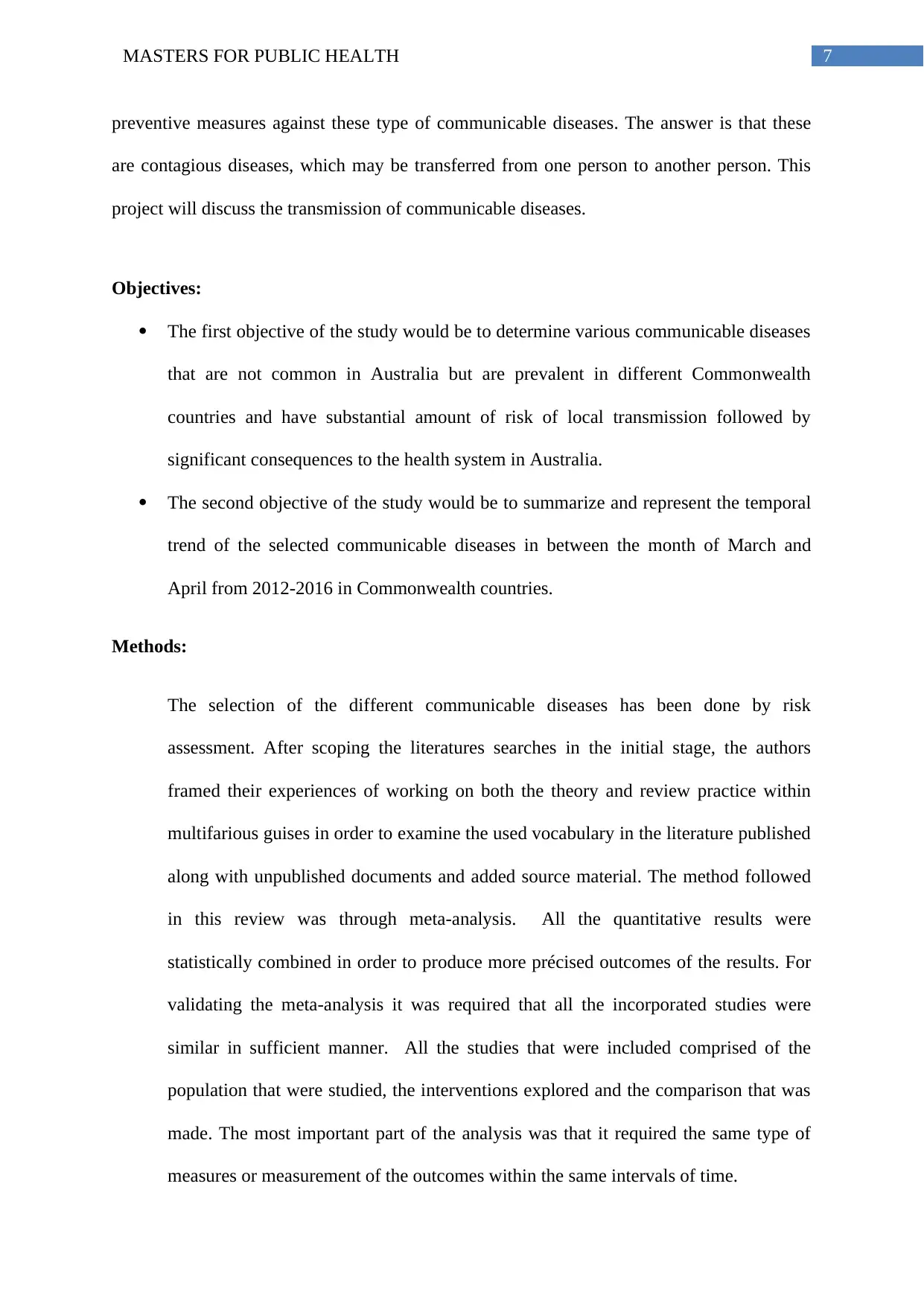
7MASTERS FOR PUBLIC HEALTH
preventive measures against these type of communicable diseases. The answer is that these
are contagious diseases, which may be transferred from one person to another person. This
project will discuss the transmission of communicable diseases.
Objectives:
The first objective of the study would be to determine various communicable diseases
that are not common in Australia but are prevalent in different Commonwealth
countries and have substantial amount of risk of local transmission followed by
significant consequences to the health system in Australia.
The second objective of the study would be to summarize and represent the temporal
trend of the selected communicable diseases in between the month of March and
April from 2012-2016 in Commonwealth countries.
Methods:
The selection of the different communicable diseases has been done by risk
assessment. After scoping the literatures searches in the initial stage, the authors
framed their experiences of working on both the theory and review practice within
multifarious guises in order to examine the used vocabulary in the literature published
along with unpublished documents and added source material. The method followed
in this review was through meta-analysis. All the quantitative results were
statistically combined in order to produce more précised outcomes of the results. For
validating the meta-analysis it was required that all the incorporated studies were
similar in sufficient manner. All the studies that were included comprised of the
population that were studied, the interventions explored and the comparison that was
made. The most important part of the analysis was that it required the same type of
measures or measurement of the outcomes within the same intervals of time.
preventive measures against these type of communicable diseases. The answer is that these
are contagious diseases, which may be transferred from one person to another person. This
project will discuss the transmission of communicable diseases.
Objectives:
The first objective of the study would be to determine various communicable diseases
that are not common in Australia but are prevalent in different Commonwealth
countries and have substantial amount of risk of local transmission followed by
significant consequences to the health system in Australia.
The second objective of the study would be to summarize and represent the temporal
trend of the selected communicable diseases in between the month of March and
April from 2012-2016 in Commonwealth countries.
Methods:
The selection of the different communicable diseases has been done by risk
assessment. After scoping the literatures searches in the initial stage, the authors
framed their experiences of working on both the theory and review practice within
multifarious guises in order to examine the used vocabulary in the literature published
along with unpublished documents and added source material. The method followed
in this review was through meta-analysis. All the quantitative results were
statistically combined in order to produce more précised outcomes of the results. For
validating the meta-analysis it was required that all the incorporated studies were
similar in sufficient manner. All the studies that were included comprised of the
population that were studied, the interventions explored and the comparison that was
made. The most important part of the analysis was that it required the same type of
measures or measurement of the outcomes within the same intervals of time.
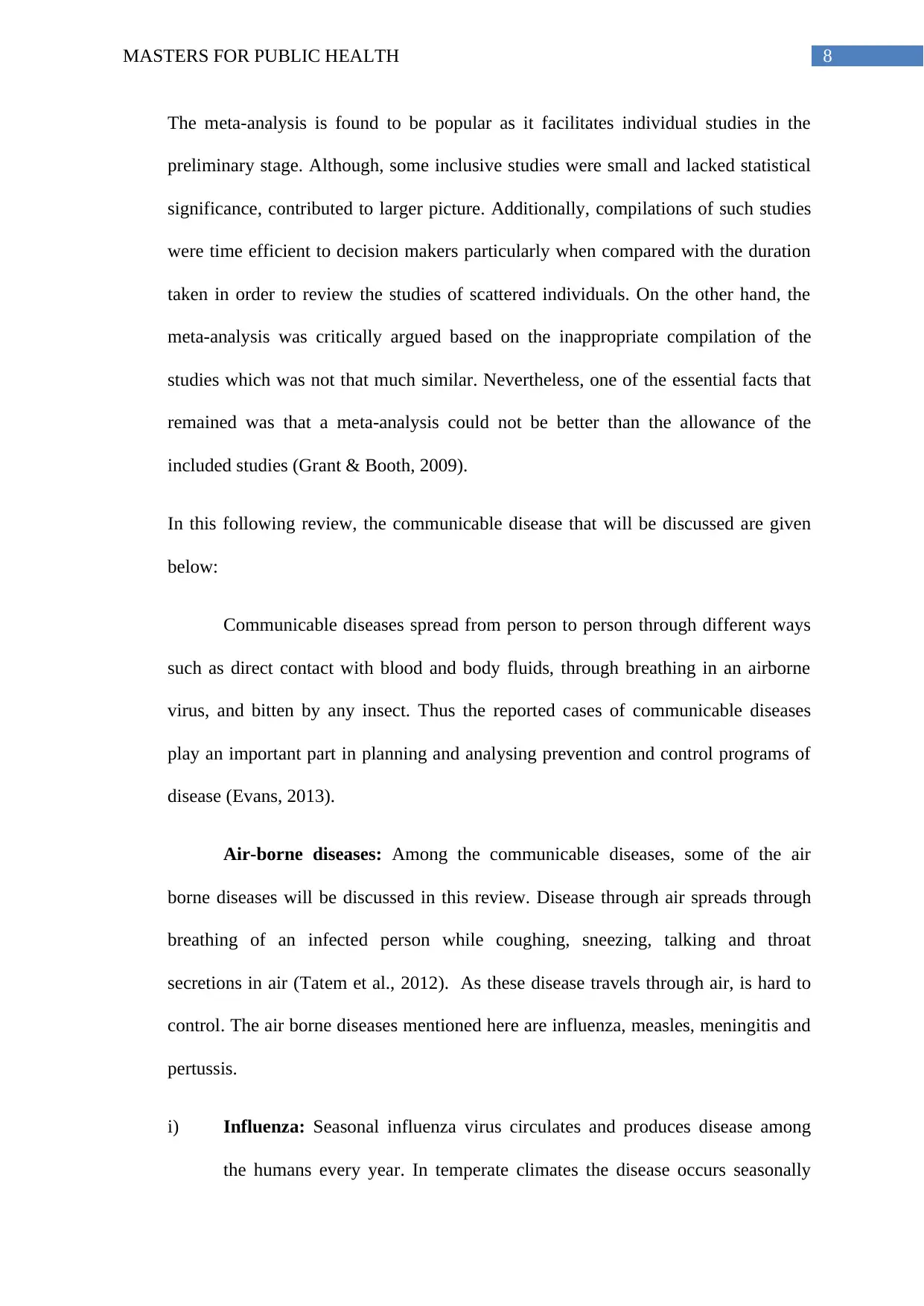
8MASTERS FOR PUBLIC HEALTH
The meta-analysis is found to be popular as it facilitates individual studies in the
preliminary stage. Although, some inclusive studies were small and lacked statistical
significance, contributed to larger picture. Additionally, compilations of such studies
were time efficient to decision makers particularly when compared with the duration
taken in order to review the studies of scattered individuals. On the other hand, the
meta-analysis was critically argued based on the inappropriate compilation of the
studies which was not that much similar. Nevertheless, one of the essential facts that
remained was that a meta-analysis could not be better than the allowance of the
included studies (Grant & Booth, 2009).
In this following review, the communicable disease that will be discussed are given
below:
Communicable diseases spread from person to person through different ways
such as direct contact with blood and body fluids, through breathing in an airborne
virus, and bitten by any insect. Thus the reported cases of communicable diseases
play an important part in planning and analysing prevention and control programs of
disease (Evans, 2013).
Air-borne diseases: Among the communicable diseases, some of the air
borne diseases will be discussed in this review. Disease through air spreads through
breathing of an infected person while coughing, sneezing, talking and throat
secretions in air (Tatem et al., 2012). As these disease travels through air, is hard to
control. The air borne diseases mentioned here are influenza, measles, meningitis and
pertussis.
i) Influenza: Seasonal influenza virus circulates and produces disease among
the humans every year. In temperate climates the disease occurs seasonally
The meta-analysis is found to be popular as it facilitates individual studies in the
preliminary stage. Although, some inclusive studies were small and lacked statistical
significance, contributed to larger picture. Additionally, compilations of such studies
were time efficient to decision makers particularly when compared with the duration
taken in order to review the studies of scattered individuals. On the other hand, the
meta-analysis was critically argued based on the inappropriate compilation of the
studies which was not that much similar. Nevertheless, one of the essential facts that
remained was that a meta-analysis could not be better than the allowance of the
included studies (Grant & Booth, 2009).
In this following review, the communicable disease that will be discussed are given
below:
Communicable diseases spread from person to person through different ways
such as direct contact with blood and body fluids, through breathing in an airborne
virus, and bitten by any insect. Thus the reported cases of communicable diseases
play an important part in planning and analysing prevention and control programs of
disease (Evans, 2013).
Air-borne diseases: Among the communicable diseases, some of the air
borne diseases will be discussed in this review. Disease through air spreads through
breathing of an infected person while coughing, sneezing, talking and throat
secretions in air (Tatem et al., 2012). As these disease travels through air, is hard to
control. The air borne diseases mentioned here are influenza, measles, meningitis and
pertussis.
i) Influenza: Seasonal influenza virus circulates and produces disease among
the humans every year. In temperate climates the disease occurs seasonally
⊘ This is a preview!⊘
Do you want full access?
Subscribe today to unlock all pages.

Trusted by 1+ million students worldwide
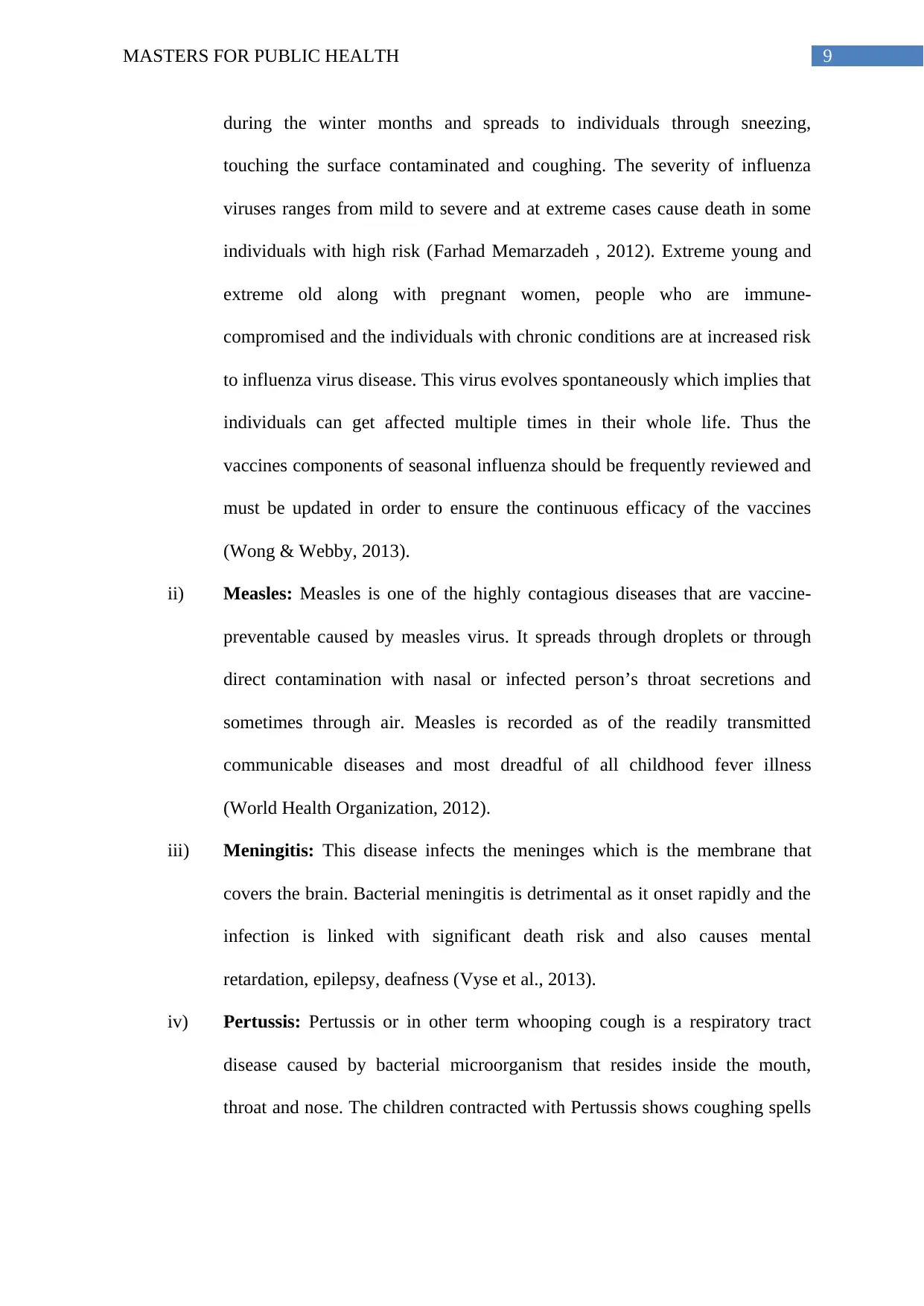
9MASTERS FOR PUBLIC HEALTH
during the winter months and spreads to individuals through sneezing,
touching the surface contaminated and coughing. The severity of influenza
viruses ranges from mild to severe and at extreme cases cause death in some
individuals with high risk (Farhad Memarzadeh , 2012). Extreme young and
extreme old along with pregnant women, people who are immune-
compromised and the individuals with chronic conditions are at increased risk
to influenza virus disease. This virus evolves spontaneously which implies that
individuals can get affected multiple times in their whole life. Thus the
vaccines components of seasonal influenza should be frequently reviewed and
must be updated in order to ensure the continuous efficacy of the vaccines
(Wong & Webby, 2013).
ii) Measles: Measles is one of the highly contagious diseases that are vaccine-
preventable caused by measles virus. It spreads through droplets or through
direct contamination with nasal or infected person’s throat secretions and
sometimes through air. Measles is recorded as of the readily transmitted
communicable diseases and most dreadful of all childhood fever illness
(World Health Organization, 2012).
iii) Meningitis: This disease infects the meninges which is the membrane that
covers the brain. Bacterial meningitis is detrimental as it onset rapidly and the
infection is linked with significant death risk and also causes mental
retardation, epilepsy, deafness (Vyse et al., 2013).
iv) Pertussis: Pertussis or in other term whooping cough is a respiratory tract
disease caused by bacterial microorganism that resides inside the mouth,
throat and nose. The children contracted with Pertussis shows coughing spells
during the winter months and spreads to individuals through sneezing,
touching the surface contaminated and coughing. The severity of influenza
viruses ranges from mild to severe and at extreme cases cause death in some
individuals with high risk (Farhad Memarzadeh , 2012). Extreme young and
extreme old along with pregnant women, people who are immune-
compromised and the individuals with chronic conditions are at increased risk
to influenza virus disease. This virus evolves spontaneously which implies that
individuals can get affected multiple times in their whole life. Thus the
vaccines components of seasonal influenza should be frequently reviewed and
must be updated in order to ensure the continuous efficacy of the vaccines
(Wong & Webby, 2013).
ii) Measles: Measles is one of the highly contagious diseases that are vaccine-
preventable caused by measles virus. It spreads through droplets or through
direct contamination with nasal or infected person’s throat secretions and
sometimes through air. Measles is recorded as of the readily transmitted
communicable diseases and most dreadful of all childhood fever illness
(World Health Organization, 2012).
iii) Meningitis: This disease infects the meninges which is the membrane that
covers the brain. Bacterial meningitis is detrimental as it onset rapidly and the
infection is linked with significant death risk and also causes mental
retardation, epilepsy, deafness (Vyse et al., 2013).
iv) Pertussis: Pertussis or in other term whooping cough is a respiratory tract
disease caused by bacterial microorganism that resides inside the mouth,
throat and nose. The children contracted with Pertussis shows coughing spells
Paraphrase This Document
Need a fresh take? Get an instant paraphrase of this document with our AI Paraphraser
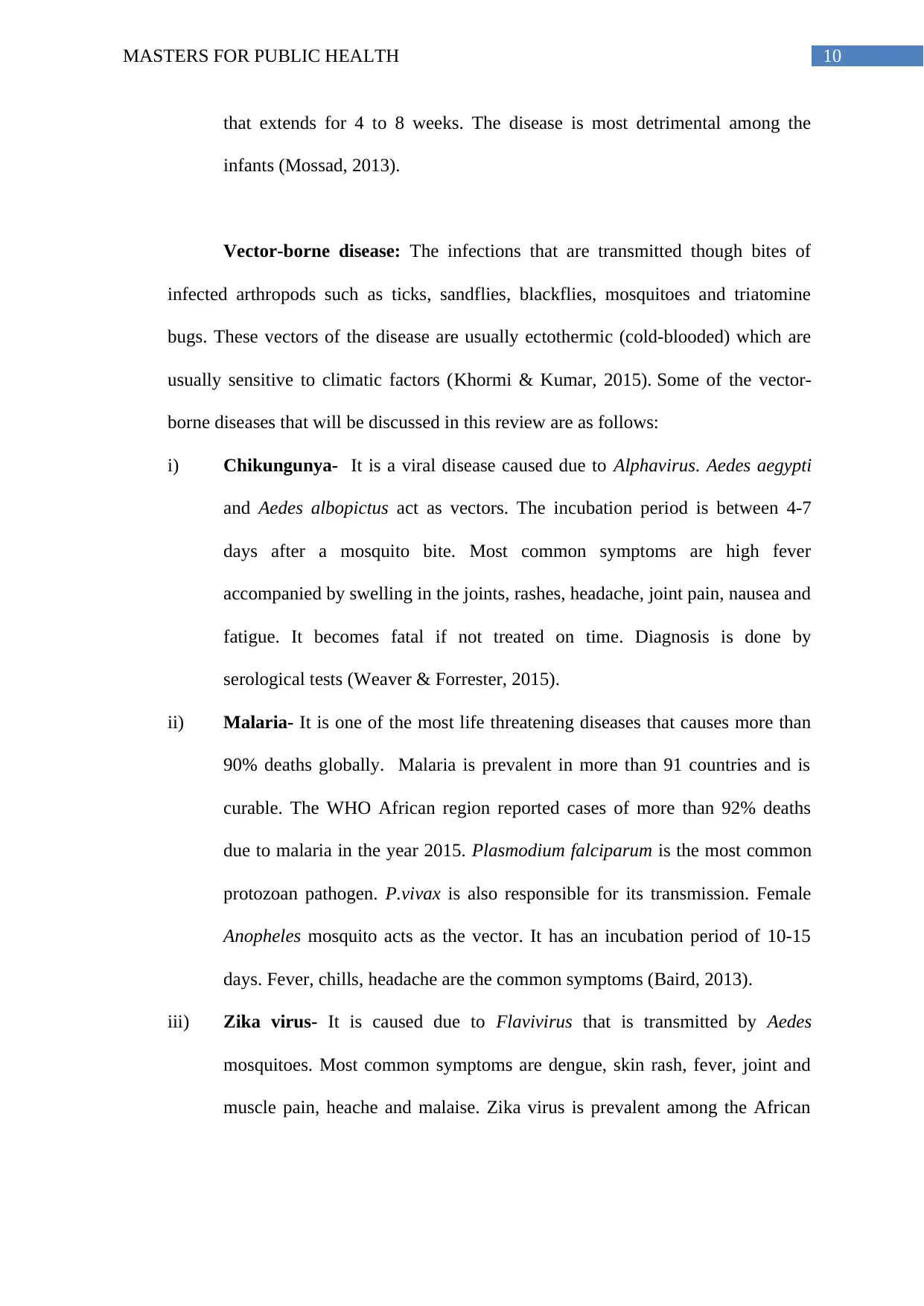
10MASTERS FOR PUBLIC HEALTH
that extends for 4 to 8 weeks. The disease is most detrimental among the
infants (Mossad, 2013).
Vector-borne disease: The infections that are transmitted though bites of
infected arthropods such as ticks, sandflies, blackflies, mosquitoes and triatomine
bugs. These vectors of the disease are usually ectothermic (cold-blooded) which are
usually sensitive to climatic factors (Khormi & Kumar, 2015). Some of the vector-
borne diseases that will be discussed in this review are as follows:
i) Chikungunya- It is a viral disease caused due to Alphavirus. Aedes aegypti
and Aedes albopictus act as vectors. The incubation period is between 4-7
days after a mosquito bite. Most common symptoms are high fever
accompanied by swelling in the joints, rashes, headache, joint pain, nausea and
fatigue. It becomes fatal if not treated on time. Diagnosis is done by
serological tests (Weaver & Forrester, 2015).
ii) Malaria- It is one of the most life threatening diseases that causes more than
90% deaths globally. Malaria is prevalent in more than 91 countries and is
curable. The WHO African region reported cases of more than 92% deaths
due to malaria in the year 2015. Plasmodium falciparum is the most common
protozoan pathogen. P.vivax is also responsible for its transmission. Female
Anopheles mosquito acts as the vector. It has an incubation period of 10-15
days. Fever, chills, headache are the common symptoms (Baird, 2013).
iii) Zika virus- It is caused due to Flavivirus that is transmitted by Aedes
mosquitoes. Most common symptoms are dengue, skin rash, fever, joint and
muscle pain, heache and malaise. Zika virus is prevalent among the African
that extends for 4 to 8 weeks. The disease is most detrimental among the
infants (Mossad, 2013).
Vector-borne disease: The infections that are transmitted though bites of
infected arthropods such as ticks, sandflies, blackflies, mosquitoes and triatomine
bugs. These vectors of the disease are usually ectothermic (cold-blooded) which are
usually sensitive to climatic factors (Khormi & Kumar, 2015). Some of the vector-
borne diseases that will be discussed in this review are as follows:
i) Chikungunya- It is a viral disease caused due to Alphavirus. Aedes aegypti
and Aedes albopictus act as vectors. The incubation period is between 4-7
days after a mosquito bite. Most common symptoms are high fever
accompanied by swelling in the joints, rashes, headache, joint pain, nausea and
fatigue. It becomes fatal if not treated on time. Diagnosis is done by
serological tests (Weaver & Forrester, 2015).
ii) Malaria- It is one of the most life threatening diseases that causes more than
90% deaths globally. Malaria is prevalent in more than 91 countries and is
curable. The WHO African region reported cases of more than 92% deaths
due to malaria in the year 2015. Plasmodium falciparum is the most common
protozoan pathogen. P.vivax is also responsible for its transmission. Female
Anopheles mosquito acts as the vector. It has an incubation period of 10-15
days. Fever, chills, headache are the common symptoms (Baird, 2013).
iii) Zika virus- It is caused due to Flavivirus that is transmitted by Aedes
mosquitoes. Most common symptoms are dengue, skin rash, fever, joint and
muscle pain, heache and malaise. Zika virus is prevalent among the African
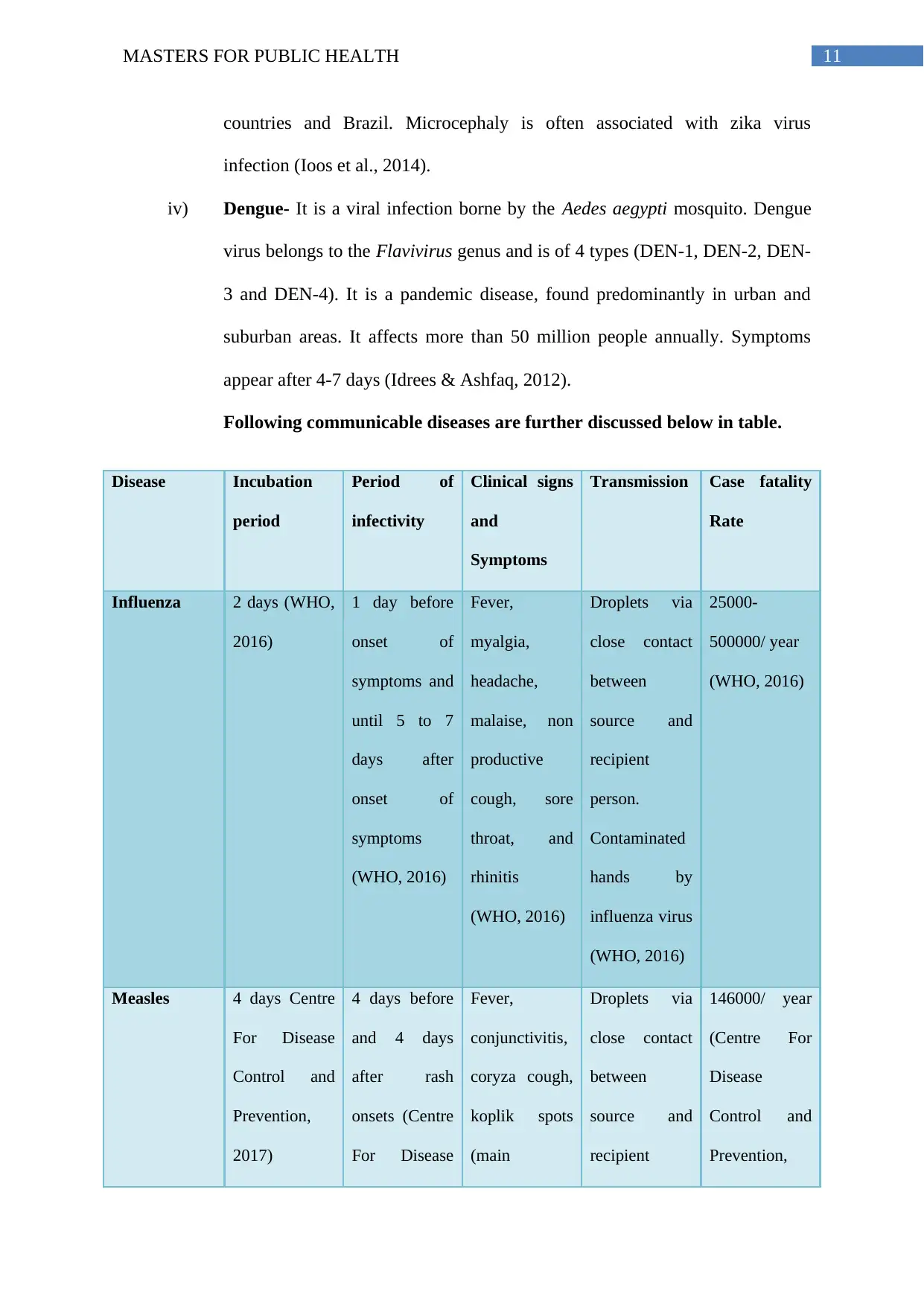
11MASTERS FOR PUBLIC HEALTH
countries and Brazil. Microcephaly is often associated with zika virus
infection (Ioos et al., 2014).
iv) Dengue- It is a viral infection borne by the Aedes aegypti mosquito. Dengue
virus belongs to the Flavivirus genus and is of 4 types (DEN-1, DEN-2, DEN-
3 and DEN-4). It is a pandemic disease, found predominantly in urban and
suburban areas. It affects more than 50 million people annually. Symptoms
appear after 4-7 days (Idrees & Ashfaq, 2012).
Following communicable diseases are further discussed below in table.
Disease Incubation
period
Period of
infectivity
Clinical signs
and
Symptoms
Transmission Case fatality
Rate
Influenza 2 days (WHO,
2016)
1 day before
onset of
symptoms and
until 5 to 7
days after
onset of
symptoms
(WHO, 2016)
Fever,
myalgia,
headache,
malaise, non
productive
cough, sore
throat, and
rhinitis
(WHO, 2016)
Droplets via
close contact
between
source and
recipient
person.
Contaminated
hands by
influenza virus
(WHO, 2016)
25000-
500000/ year
(WHO, 2016)
Measles 4 days Centre
For Disease
Control and
Prevention,
2017)
4 days before
and 4 days
after rash
onsets (Centre
For Disease
Fever,
conjunctivitis,
coryza cough,
koplik spots
(main
Droplets via
close contact
between
source and
recipient
146000/ year
(Centre For
Disease
Control and
Prevention,
countries and Brazil. Microcephaly is often associated with zika virus
infection (Ioos et al., 2014).
iv) Dengue- It is a viral infection borne by the Aedes aegypti mosquito. Dengue
virus belongs to the Flavivirus genus and is of 4 types (DEN-1, DEN-2, DEN-
3 and DEN-4). It is a pandemic disease, found predominantly in urban and
suburban areas. It affects more than 50 million people annually. Symptoms
appear after 4-7 days (Idrees & Ashfaq, 2012).
Following communicable diseases are further discussed below in table.
Disease Incubation
period
Period of
infectivity
Clinical signs
and
Symptoms
Transmission Case fatality
Rate
Influenza 2 days (WHO,
2016)
1 day before
onset of
symptoms and
until 5 to 7
days after
onset of
symptoms
(WHO, 2016)
Fever,
myalgia,
headache,
malaise, non
productive
cough, sore
throat, and
rhinitis
(WHO, 2016)
Droplets via
close contact
between
source and
recipient
person.
Contaminated
hands by
influenza virus
(WHO, 2016)
25000-
500000/ year
(WHO, 2016)
Measles 4 days Centre
For Disease
Control and
Prevention,
2017)
4 days before
and 4 days
after rash
onsets (Centre
For Disease
Fever,
conjunctivitis,
coryza cough,
koplik spots
(main
Droplets via
close contact
between
source and
recipient
146000/ year
(Centre For
Disease
Control and
Prevention,
⊘ This is a preview!⊘
Do you want full access?
Subscribe today to unlock all pages.

Trusted by 1+ million students worldwide
1 out of 35
Related Documents
Your All-in-One AI-Powered Toolkit for Academic Success.
+13062052269
info@desklib.com
Available 24*7 on WhatsApp / Email
![[object Object]](/_next/static/media/star-bottom.7253800d.svg)
Unlock your academic potential
Copyright © 2020–2025 A2Z Services. All Rights Reserved. Developed and managed by ZUCOL.





